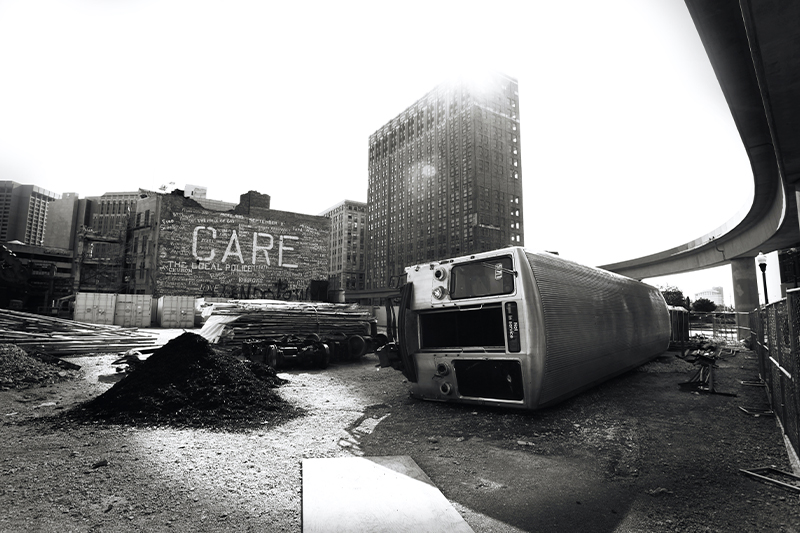
Train derailment disaster in East Palestine, Ohio
After the recent train derailment disaster in East Palestine, Ohio, many of you are likely considering how to provide employee support after a hazardous event. Hazardous events potentially threaten people, the environment, or property. These events can take many forms, ranging from natural disasters like earthquakes, floods, hurricanes, and wildfires, to technological accidents like chemical spills, power plant failures, or transportation accidents.
Hazardous events can significantly impact communities, including property damage, injury, loss of life, and long-term health effects. They can also disrupt essential services like transportation, energy, water, and communications, leading to economic losses and social disruption. In this case, a small city of under five thousand people. The transportation disaster occurred on February 3rd, shortly before 9 PM local time, when a Norfolk Southern train carrying hazardous materials derailed.

Major transporation accidents occur frequently
According to the CDC’s data, 1.35 million people are killed on roadways worldwide annually. They state that “every day, almost 3,700 people are killed globally in crashes involving cars, buses, motorcycles, bicycles, trucks, or pedestrians.” Unsurprisingly, low- and middle-income countries (LMICs) experience the most significant impacts. However, transportation incidents also include air, rail, and boat accidents. Reports indicate a dozen train derailments in the US already in 2023, and this event is the second in Ohio since January.
Although more business employees are working remotely, many are returning to travel. Additionally, data indicates the number of hybrid employees is up 24% after the pandemic. For Resilience planners, this means increased considerations of risks to employees commuting in general and the footprint of movement through communities during the day. From a risk perspective, there’s a greater likelihood of impact for vehicular and aligned accidents. The stakes become higher when a hazmat situation occurs.

Your employees want answers and support
The US Bureau of Transportation Statistics states roadway incidents far outstrip rail, air, or waterway events. Typically, we lean on local emergency management and government to address community-based disasters. That makes perfect sense. However, we must consider the effect of the event on our employees living there. Whether you are based in that location or have a satellite office, employees must understand they are your first concern.
So, I recently published a blog on the benefits of building a resilient workforce. I felt compelled to dive deeper and speak about this hazard type with this event. Of course, the guidance provided here could apply to any significant event. At the core, employees are turning to you as a trusted source of guidance and transparency. Although the company cannot do anything to fix the situation, you can alleviate their anxiety and lessen exasperation by following the outline I provide below.

The resilient program's role
To reduce the risk of hazardous events, it’s essential to identify potential hazards, assess their likelihood and potential impact, and take appropriate measures to mitigate their effects. This includes developing emergency plans, training people on responding to hazardous events, and investing in infrastructure and technologies to prevent or minimize their impact. Your crisis response, recovery, and business resumption plans should all include these aspects. Further, training on hazard-specific events can build resilience and increase employee confidence.
Environmental contamination events differ from other crises because of the long-term effects, a complex cleanup process, and (potential) ongoing risk. Additionally, there are legal implications and the sensitivity of public perception. We see that playing out with the East Palestine train derailment, where Pennsylvania officials are already taking legal action against Norfolk Southern. Additionally, Ohio’s governor closed the Ohio River temporarily out of concern, and the political fallout is already happening. From a business resilience perspective, there are applicable lessons learned to ensure your program can address and protect your organization in similar situations.

How you can provide employee support
A hazardous transportation event in a community can significantly impact the employees who work in the affected area. You can support your employees during this challenging time in several ways as an employer. Ensure that your response includes the following elements:
- Check on your employees: Contact your employees to ensure they are safe and offer support to those who may have been affected by the hazardous event.
- Provide information: Keep your employees informed about the situation and provide them with the latest updates and safety information.
- Be flexible: Allow employees to work from home or make other accommodations to help them cope. Be understanding if employees are late or absent due to transportation disruptions or other related issues.
- Offer to counsel: Consider offering counseling services or other support resources to help employees deal with the stress and trauma associated with the hazardous event.
- Provide time off: Offer time off to employees who need it to deal with the event’s aftermath or attend to personal matters related to the event.
- Review safety procedures: Review safety procedures and protocols with employees to ensure they know what to do in the event of a future hazardous event.
By offering support and understanding to your employees after a hazardous transportation event, you can help them cope and return to work as soon as possible.

Supporting employees is your Northstar
My heart goes out to all residents and people living near East Palestine, Ohio. The town’s website shows they are taking the right approach to be transparent with citizens. A health clinic was opened, FAQ sheets were posted, and air and water quality results were available for viewing. The non-governmental organizations available to assist with recovery are posted there. Undoubtedly, first responders and emergency management teams are working around the clock to mitigate the damage to their city.
As Resilience Professionals, we would approach internal crisis response similarly. Communications teams would be sharing messaging with both internal and external stakeholders. The corporate crisis team would meet on-going until the event was resolved. The goal is to limit additional damage and resume operations whenever possible. My blog on the Boeing 737 Max crash outlines my suggestions about Reputation Management After A Crisis Event. Yet, although this is a vital aspect of crisis response, a company will not survive without a resilient workforce. Employees must be your priority in all planning and crisis management aspects.
Did you know?
Disaster Empire blogs contain embedded links to source materials, articles of interest, videos, books, and training I recommend. Just click on the blue embedded link to access the resource.
